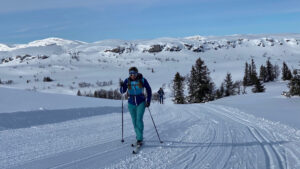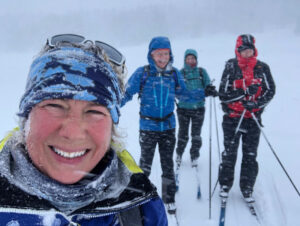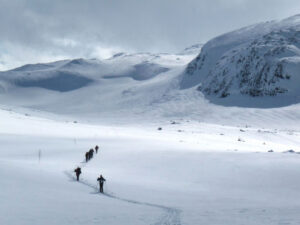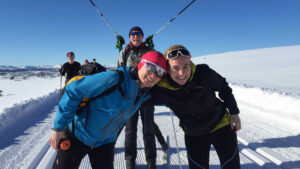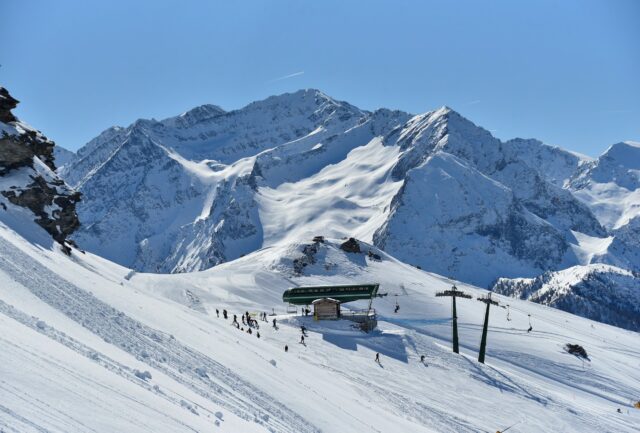Introducing Lindsay, Tracks & Trails expert guide and BASI-qualified Nordic Ski Instructor with an unmatched passion for teaching and skiing. This winter, she’s taking her dedication to a whole new level by moving to Norway to fully immerse herself in the world of cross-country skiing. With her wealth of experience and enthusiasm, we thought it was the perfect time to sit down with Lindsay and dive into her insights on cross-country skiing, from foundational skills to advanced techniques, and where those skills can ultimately lead.
What does the learning journey look like in cross-country skiing, especially for someone just starting out?
Lindsay: When you’re starting out, it’s a bit like “Bambi on ice”—those first steps can feel wobbly because the gear is light and super dynamic. But that’s also the beauty of it. With just a few hours of guided play, like fun drills to feel out the skis, you’re not even realizing it’s a lesson. Very quickly, beginners start to get the hang of it. From there, it’s about building a solid technique, which is the foundation for everything that follows.
Once you’re comfortable on your skis, you naturally want more than just the stadium; you want to journey. That’s the moment you’re ready for the bigger picture—open winter landscapes, quiet trails, and the freedom of moving through snow-covered forests and fields.
What advanced techniques or goals should skiers set their sights on after mastering the basics?
Lindsay: After building a solid foundation on groomed cross-country ski tracks, a whole new level of adventure becomes possible. With the basics down, you’re ready for our point-to-point journeys, which let you experience the mountains in an entirely different way.
Take, for instance, the Tracks & Trails Hallingdal ski trip in Norway. This journey begins in Geilo and covers over 145km (90 miles) through beautiful, varied terrain. You’ll ski along marked trails that pass through remote valleys, staying in charming hotels and mountain lodges while your luggage is transported for you. It’s cross-country ski touring at its finest, but we also have trips that offer a more gradual progression. These options are perfect for building confidence in “journeying on skis” before setting out on more challenging tours.
If you’re still craving more, you can start aiming for the next step: moving from “track” skiing to “off-track” skiing. Off-track touring takes cross-country skiing up a notch, using the same techniques but with slightly sturdier equipment. It’s a different ball game—you’ll carry all your gear for the week in a rucksack since there’s typically no vehicle access for luggage. Preparation becomes key: making sure you have the right equipment, the right clothing, and the readiness to manage yourself in varied weather. It’s the ultimate adventure and a true test of skill and self-sufficiency. Find out more about off-track skiing here.
How do cross-country skiing skills apply to other snow sports or activities outside skiing?
Lindsay: Cross-country skiing builds balance, endurance, and core strength, which are useful in all sorts of ways. For alpine skiing, you’ll notice your core stability improves, making you more efficient and giving greater control on the slopes. It’s also a great foundation for backcountry skiing and mountain touring; you’re developing that “kick and glide” movement, which is ideal for ski touring. Runners often love it as a low-impact way to train, providing a full-body workout while giving those joints a break.
However, you do not need to be an ‘athlete’ to enjoy cross-country. We have many guests who simply want the joy of moving across the snow in winter. All you need is a reasonable level of fitness and be someone who enjoys the outdoors and exercise.
Do you have to be an alpine skier to join cross-country skiing trips?
Lindsay: Not at all! Cross-country skiing is a completely unique experience. While we’re still gliding over snow, the techniques, equipment, and overall feel are quite different from alpine skiing. In fact, many people with no skiing background pick it up quickly. Runners, for example, often appreciate cross-country as a refreshing winter alternative for building endurance, though it’s very much its own skill set.
Ski Club of Great Britain and Tracks & Trails have partnered to expand their offerings with cross-country adventures, welcoming skiers of all levels. Members of the Ski Club will receive 5% discount on selected trips, to redeem this offer head to the discounts page.
No previous experience is needed—just a willingness to embrace the journey and enjoy the unique adventures that cross-country skiing brings.
Should beginners master classic technique before trying skate skiing, or can they learn both simultaneously?
Lindsay: I wouldn’t recommend learning both at once—muscle memory can get in the way and switching back and forth can be confusing. Generally, classic skiing style is easier to start with and offers more versatility, especially if you’re drawn to long, scenic journeys. Skate skiing is more intense, a real workout that requires strength and stability. Classic skiing has a rich history too; it’s the original form of skiing, dating back to ancient times, and still, to this day, the ideal way to explore vast winter landscapes.
What fitness areas does cross-country skiing target most, and how can skiers supplement their training off the slopes?
Lindsay: Cross-country skiing is known for building endurance, targeting the legs, core, and upper body. If you’re looking to tackle longer routes, off-season training is helpful. Lunges are great because they mimic the “kick” action and strengthen the hip flexors. Roller skiing is another good option if you can access it locally, as it helps keep the ski muscles tuned. There are many Roller Ski Clubs across the UK, and USA, and indeed throughout Europe.
How can skiers approach cross-country skiing in an eco-friendly way?
Lindsay: This is the beauty of Cross-country skiing – it is low-impact by nature—there’s no infrastructure left behind, and when the snow melts, the trails disappear. Waxes are now mostly non-fluorinated, which means fewer harmful chemicals. Plus, some of our trips are designed to be accessed by train, minimizing the carbon footprint. Nordic skiing connects you deeply to nature, and you get to appreciate the pristine wilderness—like catching glimpses of wildlife or ice formations just outside villages. These experiences foster a desire to keep those places wild and unspoiled.
How can skiers recognize when they’re ready for more challenging routes or conditions?
Lindsay: Tracks & Trails has developed a grading system to help skiers track their progress and set long-term goals, whether you’re just starting or experienced. At the end of each trip, instructors are happy to discuss your progress and suggest the next steps for personal growth and skill development. This way, you can always look ahead to the next adventure with confidence. But we want to stress that our trips are holidays! Learning is fun, but the real emphasis is on you having a break from your routine while enjoying the beauty of the winter mountains.
What are the social and community aspects of learning cross-country skiing?
Lindsay: Cross-country skiing is fantastic to learn in a group setting. Observing others can help you grasp techniques more intuitively, and it’s encouraging to learn alongside people facing the same challenges and triumphs. Tracks & Trail’s beginner trips, like the Italian ski break, have a small group size of six, ensuring everyone receives personal attention and makes steady progress. Other on- and off-track trips have a maximum of eight participants, keeping the atmosphere friendly and supportive.
There’s a strong sense of community—many of our guests return year after year, reconnecting with friends they’ve made on the trails. Whether you’re a newcomer or a returning guest, it’s like joining a family of fellow cross-country enthusiasts, sharing a passion for the sport.
What are some long-term goals for cross-country skiers?
Lindsay: A lot of skiers want to keep progressing to tackle new adventures—maybe that means going from on-track to off-track, or eventually participating in iconic races like the Vasaloppet or Birkebeiner. There are so many exciting goals, and we’re here to help each skier find their own unique path.
It’s fascinating to see how cross-country skiing provides such an enriching journey. Lindsay’s passion and experience really bring out the spirit of this sport, showing just how many doors it opens once you’re comfortable on skis. I’m genuinely excited to see what this winter will bring and would love to hear your thoughts or answer any questions if you’re curious to learn more. Here’s to discovering new trails and the endless possibilities of winter!
Ski Club members have an exclusive 5% discount on Tracks & Trails holidays, to find out more head to our discounts page.


